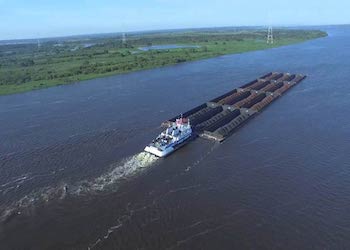Drug trafficking routes are starting to appear along rivers and canals in Bolivia, threatening to complicate efforts to stop the flow of cocaine to international markets.
The United Nations reports that drug traffickers have begun using the Paraguay-Paraná watershed on the eastern border of the country, which connects it to river systems across the region and facilitates access to buyers in Europe and Africa.
“Drug traffickers have readjusted,” Thierry Rostan, a representative for the UN Office on Drugs and Crime (UNODC), said in December. “They have organized cocaine collection areas and shipped to different countries in the region.”
Bolivia’s eastern border is equipped with several canals that connect to the Paraguay River in Brazil. It’s one of the longest rivers in South America, running south into Paraguay before joining the Paraná River in Argentina and emptying into the Atlantic. This means that traffickers have a new way of moving cocaine internationally.
“It is a major concern,” Rostan said.
Officials in Bolivia reported that a majority of cocaine laboratories destroyed this year were in the coca-producing region of Cochabamba, in the center of the country. It’s an easy connection point to water routes on the border, like Port Busch and Port Quijarro, officials said.
SEE ALSO: Bolivia’s New President Faces Complex Drug Scenario
Bolivia, as a landlocked country, has been looking for new ways to expand maritime shipping. It started increasing its use of the Paraguay-Paraná watershed around 2018, after losing a five-year battle in The Hague that would have returned a slice of Chile’s Pacific coast, lost in 1884.
The country shipped over a million tons of products in 2018 and 2019 — mostly soybeans, beef and other agriculture staples of the Bolivian economy. Former President Evo Morales named 2020 the “year of the Atlantic” and shifted around fifty percent of the country’s international cargo to eastern river routes.
InSight Crime Analysis
Fluvial drug trafficking routes will become increasingly popular with Bolivian criminal networks as the country invests more in maritime shipping, adding new trafficking dynamics in the world’s third-largest producer of cocaine.
Additionally, Bolivia acts as a transit point for illicit goods traveling from Peru — the world’s second-largest producer of cocaine. Should a sustainable means of drug transport continue to develop in eastern Bolivia, traffickers could divert drugs from other routes and choose to send more shipments toward the waterway.
SEE ALSO: Cocaine Seizures On the Rise At Bolivia-Brazil Border
The country’s landlocked status has historically left traffickers to work with land and air routes through Paraguay and Brazil. The drugs are then moved on to major international port cities like Rio de Janeiro. Planes tend to take advantage of scarcely populated regions, such as the department of Beni to the north, or Paraguay’s arid Chaco region to the southeast. Drugs can also be driven across the border in vehicles.
With the development of river transport, Bolivia will have to make sure it is up to date on strategies that coastal nations use to detect drugs concealed in the overwhelming number of shipping containers leaving port. This could include improving gamma-ray radiography systems that scan containers, training canine units and implementing efforts to root out corruption among port authorities.
More specifically, UNODC officials suggested that Bolivia implement the Global Container Control Programme, which provides training on how to detect tampered shipping containers and facilitates inter-agency communication. UN officials also suggested that Bolivia work with the multi-agency AIRCOP program, which assists in the detection and interception of cocaine sourced in Latin America.


